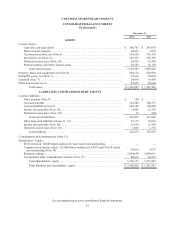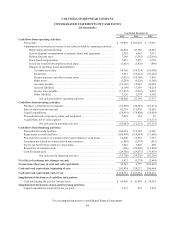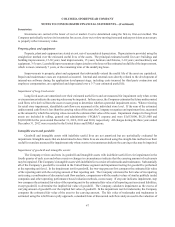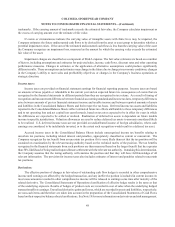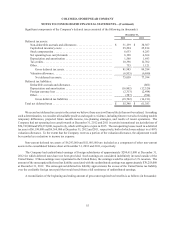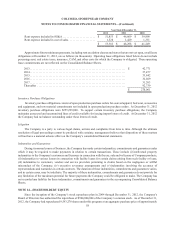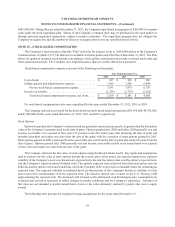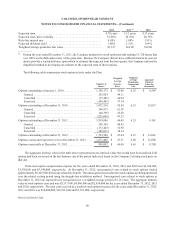Columbia Sportswear 2012 Annual Report Download - page 54
Download and view the complete annual report
Please find page 54 of the 2012 Columbia Sportswear annual report below. You can navigate through the pages in the report by either clicking on the pages listed below, or by using the keyword search tool below to find specific information within the annual report.COLUMBIA SPORTSWEAR COMPANY
NOTES TO CONSOLIDATED FINANCIAL STATEMENTS—(Continued)
50
subjective assumptions, including volatility and expected option life. Further, the Company estimates forfeitures for stock-
based awards granted which are not expected to vest. For restricted stock unit awards subject to performance conditions,
the amount of compensation expense recorded in a given period reflects the Company's assessment of the probability of
achieving its performance targets. If any of these inputs or assumptions changes significantly, stock-based compensation
expense may differ materially in the future from that recorded in the current period. Assumptions are evaluated and revised
as necessary to reflect changes in market conditions and the Company’s experience. Estimates of fair value are not intended
to predict actual future events or the value ultimately realized by people who receive equity awards. The fair value of
service-based and performance-based restricted stock units is discounted by the present value of the estimated future stream
of dividends over the vesting period using the Black-Scholes model.
Advertising costs:
Advertising costs are expensed in the period incurred and are included in SG&A expenses. Total advertising expense,
including cooperative advertising costs, was $76,714,000, $85,003,000 and $77,978,000 for the years ended December 31,
2012, 2011 and 2010, respectively.
Through cooperative advertising programs, the Company reimburses its wholesale customers for some of their costs
of advertising the Company’s products based on various criteria, including the value of purchases from the Company and
various advertising specifications. Cooperative advertising costs are included in expenses because the Company receives
an identifiable benefit in exchange for the cost, the advertising may be obtained from a party other than the customer, and
the fair value of the advertising benefit can be reasonably estimated. Cooperative advertising costs were $7,851,000,
$8,554,000 and $7,259,000 for the years ended December 31, 2012, 2011 and 2010, respectively.
Recent Accounting Pronouncements:
In May 2011, the Financial Accounting Standards Board (“FASB”) issued Accounting Standards Update (“ASU”)
No. 2011-04, Fair Value Measurement (Topic 820): Amendments to Achieve Common Fair Value Measurement and
Disclosure Requirements in U.S. GAAP and IFRS. This ASU was issued concurrently with International Financial Reporting
Standards (“IFRS”) 13 Fair Value Measurements, to provide largely identical guidance about fair value measurement and
disclosure requirements. The new standards do not extend the use of fair value but, rather, provide guidance about how fair
value should be applied where it already is required or permitted under IFRS or U.S. GAAP. The Company adopted this
standard January 1, 2012. The adoption of this standard did not have a material effect on the Company's consolidated
financial position, results of operations, or cash flows.
In June 2011, the FASB issued ASU No. 2011-05, Comprehensive Income (Topic 220): Presentation of Comprehensive
Income. This ASU increases the prominence of other comprehensive income in financial statements while eliminating the
option in U.S. GAAP to present other comprehensive income in the statement of changes in equity. Under this ASU, an
entity has the option to present the components of net income and comprehensive income in either one or two consecutive
financial statements. The Company adopted this standard January 1, 2012, and applied it retrospectively by adding a separate
financial statement entitled, "Consolidated Statements of Comprehensive Income."
In September 2011, the FASB issued ASU No. 2011-08, Intangibles—Goodwill and Other (Topic 350): Testing
Goodwill for Impairment. This ASU permits an entity to make a qualitative assessment of whether it is more likely than
not that a reporting unit’s fair value is less than its carrying amount before applying the two-step goodwill impairment test.
Under these requirements, an entity would not be required to calculate the fair value of a reporting unit unless the entity
determines, based on the qualitative assessment, that it is more likely than not that its fair value is less than its carrying
amount. The Company adopted this standard January 1, 2012. The adoption of this standard did not have a material effect
on the Company’s consolidated financial position, results of operations or cash flows.
In July 2012, the FASB issued ASU No. 2012-02, Intangibles—Goodwill and Other (Topic 350): Testing Indefinite-
Lived Intangible Assets for Impairment. This ASU permits an entity to make a qualitative assessment of whether it is more
likely than not that indefinite-lived intangible assets are impaired before calculating the fair value of the assets. This ASU



